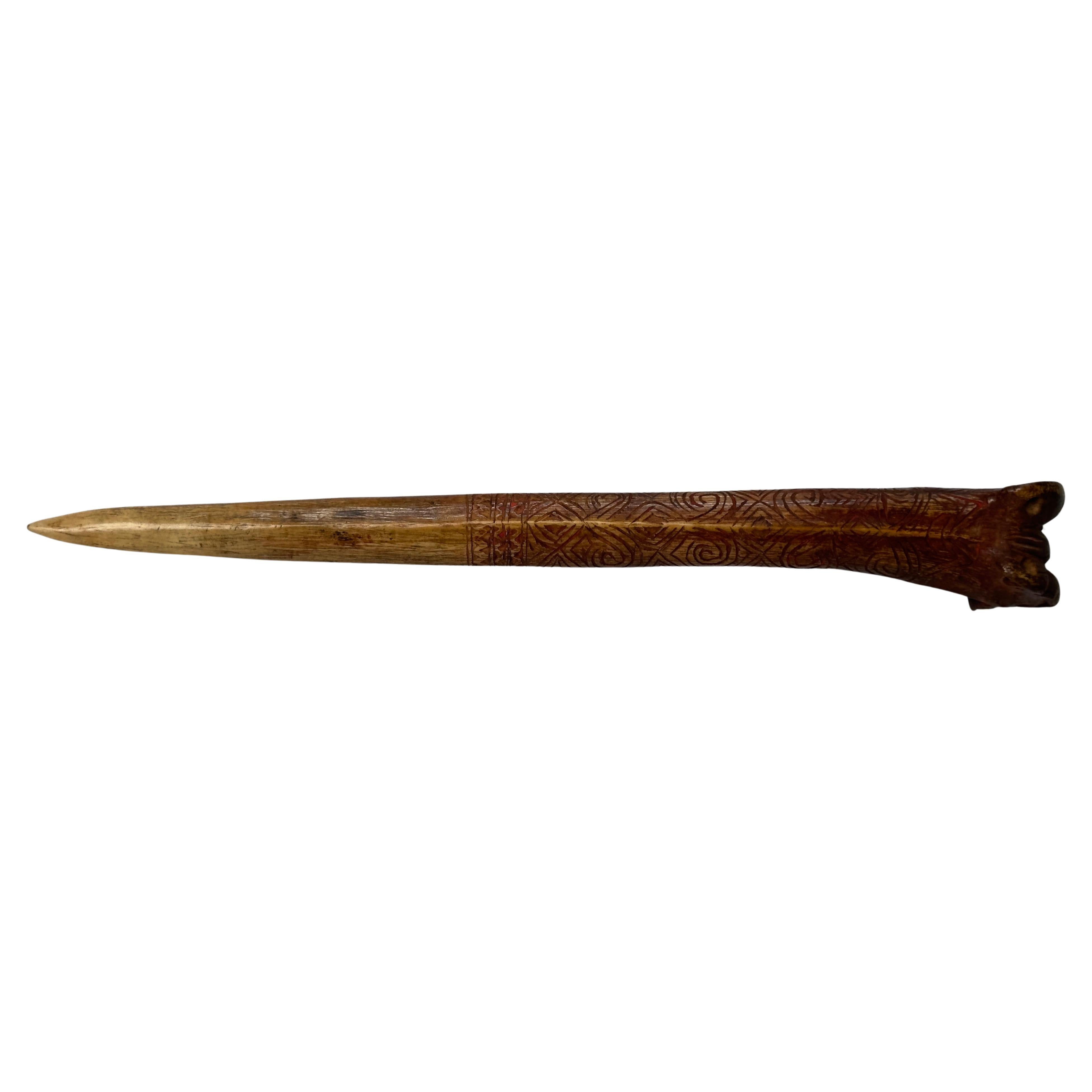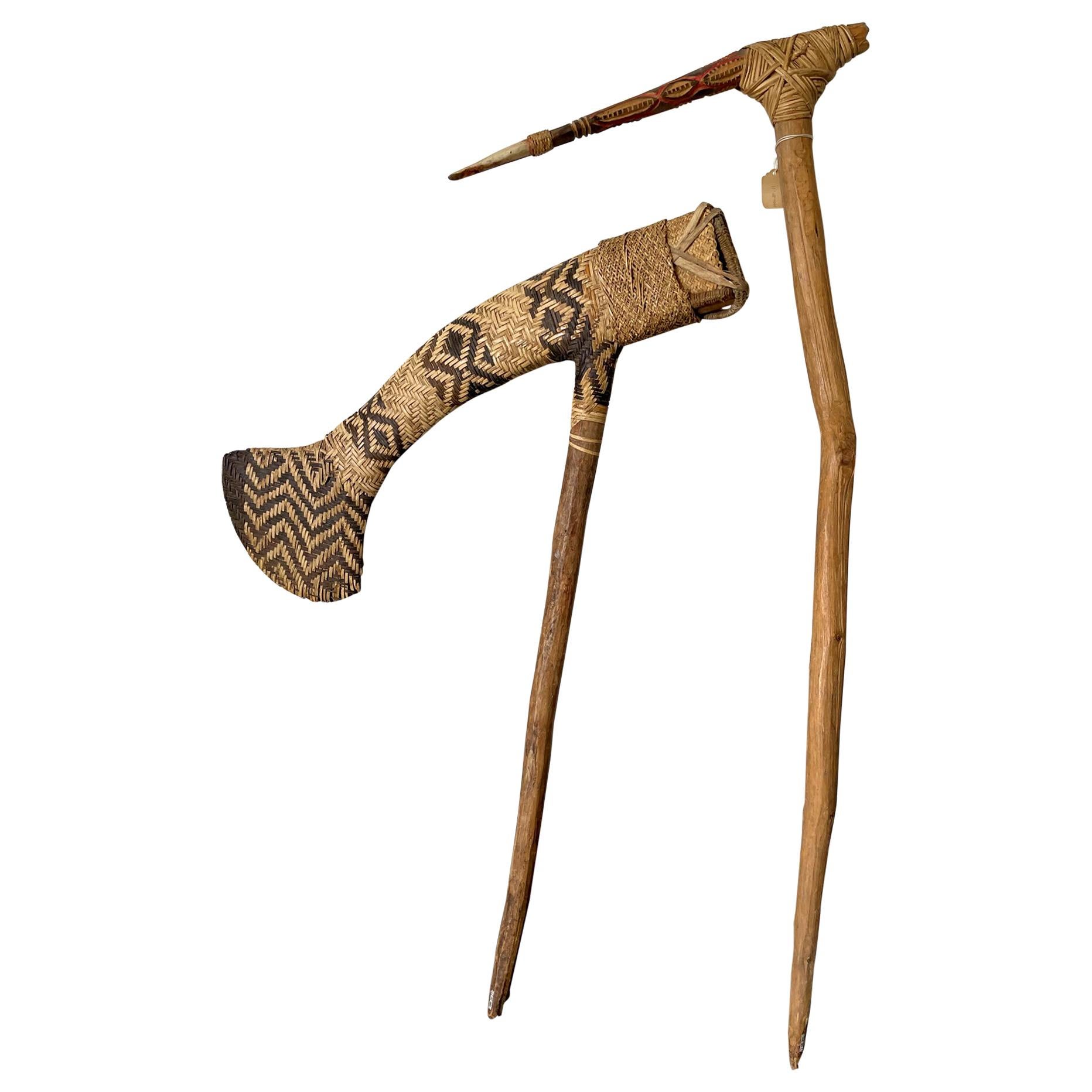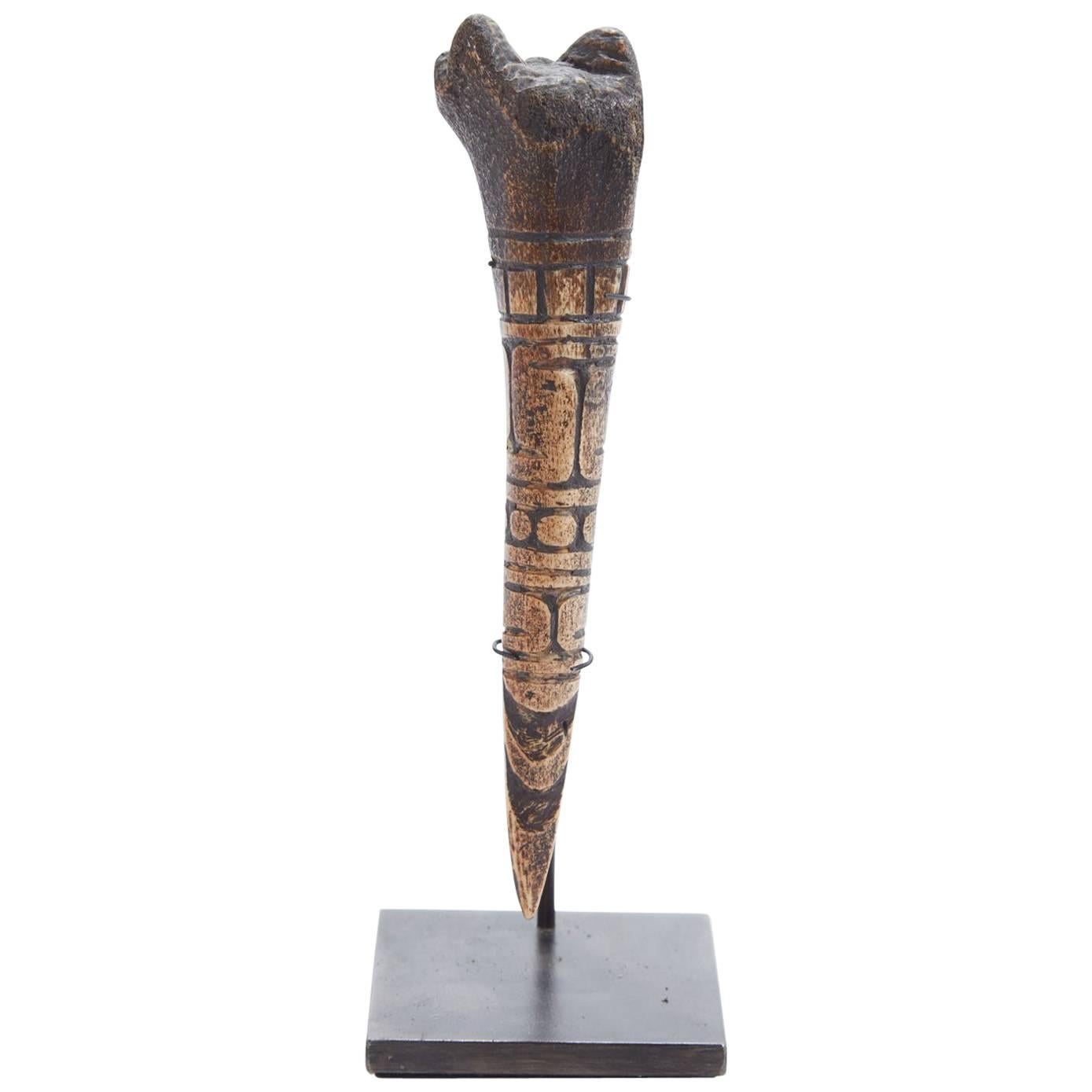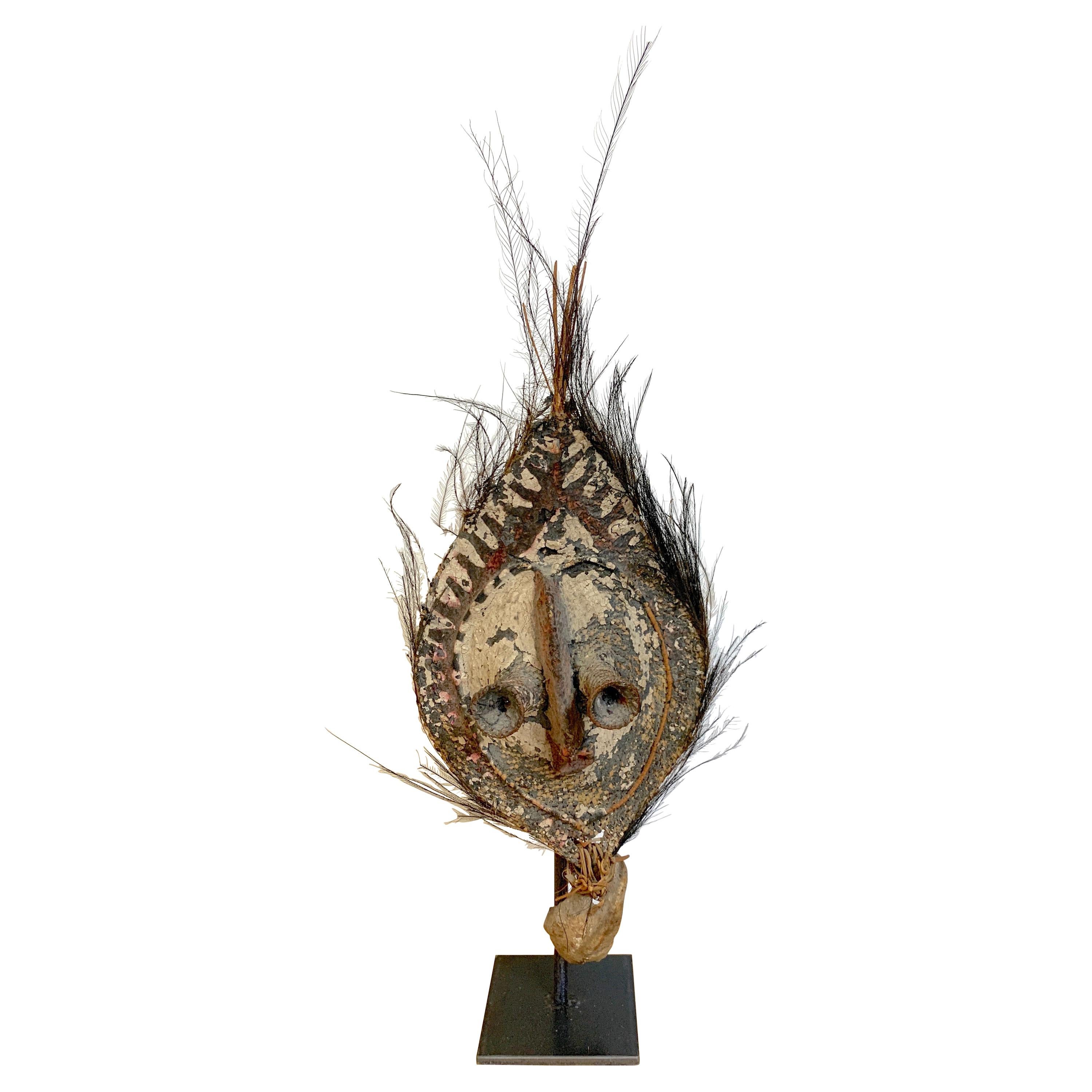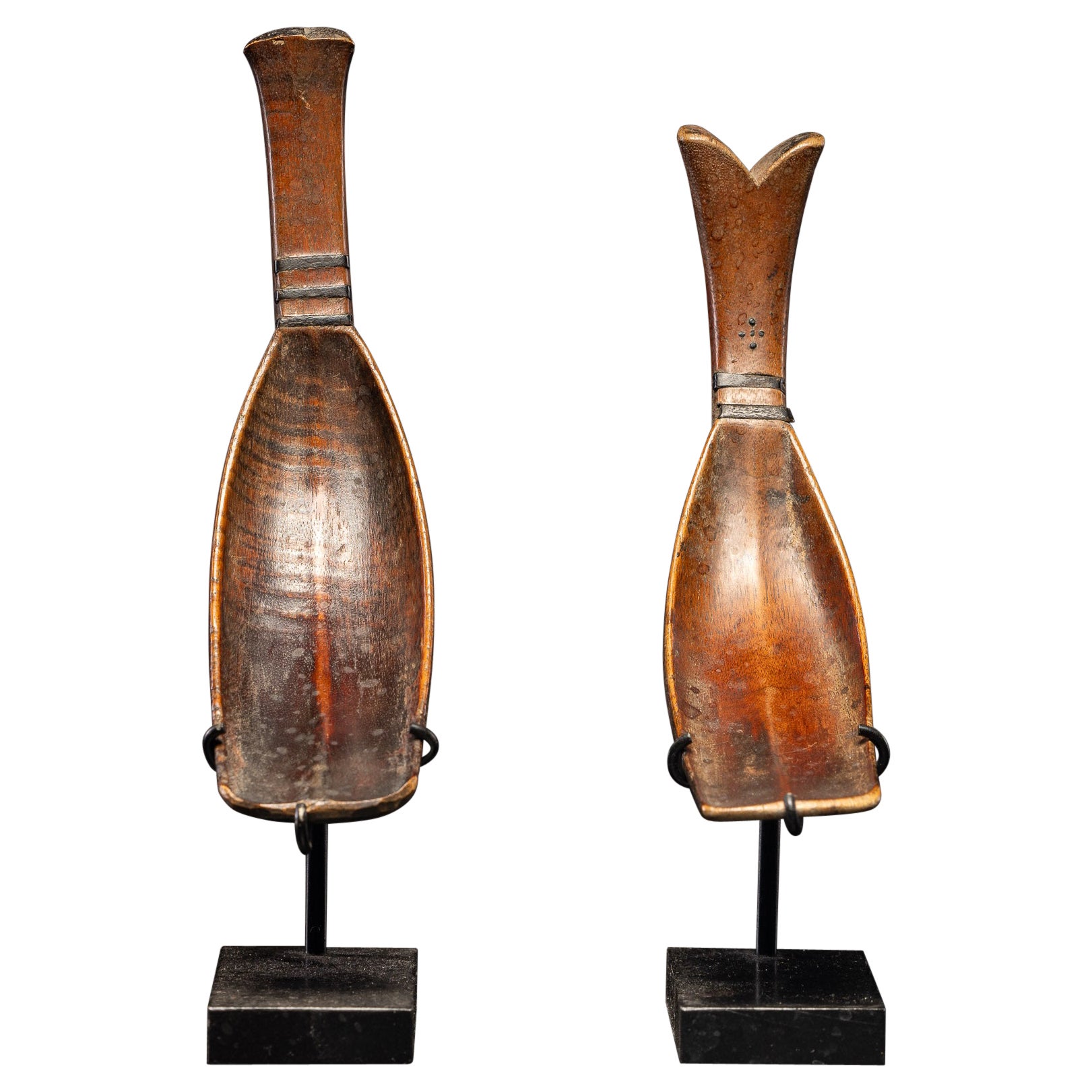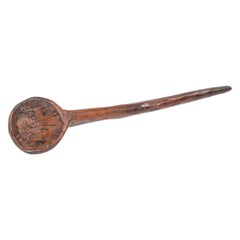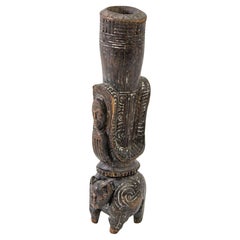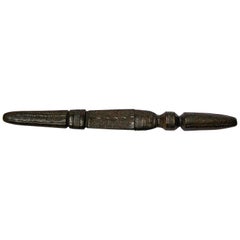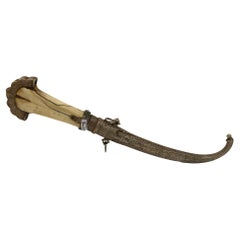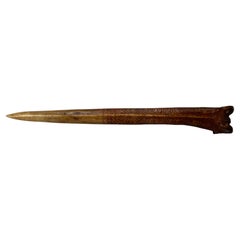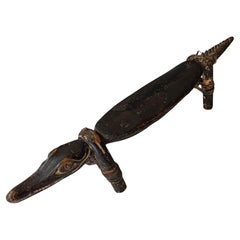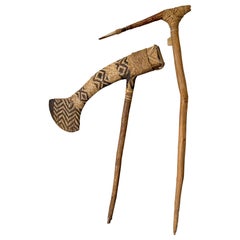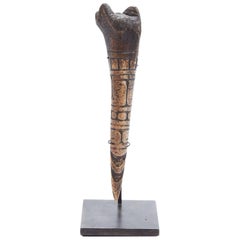Items Similar to Antique Ethnic Artifact Sepik River Cassowary Bone from Papua New Guinea
Video Loading
Want more images or videos?
Request additional images or videos from the seller
1 of 22
Antique Ethnic Artifact Sepik River Cassowary Bone from Papua New Guinea
$650
£493.69
€567.83
CA$908.18
A$1,012.72
CHF 528.39
MX$12,426.46
NOK 6,725.62
SEK 6,372.38
DKK 4,237.96
Shipping
Retrieving quote...The 1stDibs Promise:
Authenticity Guarantee,
Money-Back Guarantee,
24-Hour Cancellation
About the Item
Antique Ethnic Artifact Sepik River Cassowary Bone from Papua New Guinea
For many groups in Papua New Guinea, bone was an important medium for making tools of all types. This artifact is made from leg bone of a cassowary, a large, flightless, and extremely dangerous, bird.
Cassowaries also play an important role in the mythology of groups in the Sepik River area.
Though no longer used these bone artifacts are still used ceremonially. They often play important roles in male initiation and other rituals. They are also worn as personal adornment by tucking them into a band of braided fibers worn around the upper arm.
Antique Ethnic Bone Cassowary Artifact with minimal carving and incised design confined to the joint end.
A small hole has been drilled through from both sides of the top and presumably for the threading of a cord.
The bone has been partially divided near the top and to form two prongs that project down the back of the dagger possibly allowing the user to wear is tuck into a waist band or belt.
Origin Papua New Guinea Maprik Dist Area
From the Art Collection of Marian and John Scott, acquired in 1962.
Similar items are in display in the Timothy S. Y. Lam Museum of Anthropology.
Purchased from the amazing private collection of Mark Lissauer who spent his life collecting niche ethnographic pieces.
About Mark Lissauer:
Mark Lissauer spent forty years travelling abroad for months at a time collecting ethnographic artefacts primarily from New Guinea and the islands of the West Pacific, and from Asia and Himalayan countries. Fluent in five languages and having in the course of business travelled to more than forty countries, Mark is well-known to museums and art-collectors around the world for his long career and his interesting and diverse collection of rare ethnographic material.
Mark knows the origin and symbolism of each piece. Through extensive research and more than ninety trips around the globe, Mark familiarised himself with the traditions of the various cultures he visited in order to understand the meaning of each object to its region and tribe. His home has a specialist library and several rooms are filled with tribal carvings, textiles and ethnographica.
He acquired his first tribal piece in 1948 during a business trip to Milne Bay, New Guinea, and has since documented the acquisition of some 35,000 items. Several thousands of these have been sold to important private collections and museums worldwide, including the Rockefeller Museum, the British Museum and the Musée National des Arts d’Afrique et d’Océanie, now incorporated into the Louvre Museum.
Estimator certificate of authenticity by Wayne Heathcote Tribal Art Dealer and Expert.
Heathcote has a flash gallery in Brussels, where much of the tribal art business is centred, and is an expert at Sotheby's tribal art sale, one of two it holds each year in New York.
Many of the pieces in the sale also bore his provenance, proudly stated by vendors in the catalogue.
- Dimensions:Height: 1.25 in (3.18 cm)Width: 7.5 in (19.05 cm)Depth: 1.5 in (3.81 cm)
- Style:Folk Art (In the Style Of)
- Materials and Techniques:
- Period:
- Date of Manufacture:1900
- Condition:
- Seller Location:North Hollywood, CA
- Reference Number:Seller: DE12231stDibs: LU906837787772
About the Seller
5.0
Platinum Seller
Premium sellers with a 4.7+ rating and 24-hour response times
1stDibs seller since 2011
3,047 sales on 1stDibs
Typical response time: 1 hour
- ShippingRetrieving quote...Shipping from: North Hollywood, CA
- Return Policy
Authenticity Guarantee
In the unlikely event there’s an issue with an item’s authenticity, contact us within 1 year for a full refund. DetailsMoney-Back Guarantee
If your item is not as described, is damaged in transit, or does not arrive, contact us within 7 days for a full refund. Details24-Hour Cancellation
You have a 24-hour grace period in which to reconsider your purchase, with no questions asked.Vetted Professional Sellers
Our world-class sellers must adhere to strict standards for service and quality, maintaining the integrity of our listings.Price-Match Guarantee
If you find that a seller listed the same item for a lower price elsewhere, we’ll match it.Trusted Global Delivery
Our best-in-class carrier network provides specialized shipping options worldwide, including custom delivery.More From This Seller
View AllHand Carved Wood Moroccan Ethnic Large Spoon
By Berber Tribes of Morocco
Located in North Hollywood, CA
Hand Carved antique African Moroccan burl wood large spoon.
Large Moroccan ethnic folk art hand crafted and carved large cooking spoon.
Great patina, rou...
Category
Early 20th Century Moroccan Folk Art Sculptures and Carvings
Materials
Wood
Stirrup Vessel Wood Hand- Carved Massim People Papua New Guinea
Located in North Hollywood, CA
Wood Carved Stirrup Vessel, or Pipe, Massim people, Trobriand Islands, Papua New Guinea.
Hand-carved wood in the form of a large animal with a top ci...
Category
Early 20th Century Papua New Guinean Tribal Sculptures and Carvings
Materials
Wood
African Moroccan Tribal Tuareg Khoumya Leather Dagger Paper Cutter
By Berber Tribes of Morocco
Located in North Hollywood, CA
African Moroccan Tuareg tribal Khoumya arm dagger in dark brown leather sheath.
great to use as a paper cutter on desk.
Handcrafted by Artisans in south Morocco, very fine quality craftsmanship with a stamped leather engraved with Moroccan Tuareg geometric tribal designs.
The arm dagger was a weapon widely used by people across Africa in the Sahara and Sudanic Africa, from the central Sahara to North Cameroon, from Nigeria to Somalia.
It was worn in a sheath attached to the inner side of the left forearm by a loop,
Metal steel blade shows some rust, leather in very good condition.
Size: 13 inches length x widest part 1.5 inches. Blade is 1 inch.
Africa, Morocco circa 1940s.
Great Islamic antique Nomadic Tuareg knife dagger...
Category
Mid-20th Century Moroccan Folk Art Arms, Armor and Weapons
Materials
Metal
Moroccan Tribal Sterling Silver Khoumya Dagger
By Berber Tribes of Morocco
Located in North Hollywood, CA
Moroccan sterling silver collector dagger with filigree designs handcrafted by artisans in Morocco, very Fine quality craftsmanship with a camel bone grip engraved with Moroccan silv...
Category
Antique Late 19th Century Moroccan Islamic Arms, Armor and Weapons
Materials
Sterling Silver
Moroccan Brass Decorative Collector Dagger
By Berber Tribes of Morocco
Located in North Hollywood, CA
Handcrafted Moroccan brass dagger, mixed metal, copper, nickel and enamel.
Moroccan Hand carved Khoumiya dagger, of typical shape with curved bla...
Category
Late 20th Century Moroccan Folk Art More Furniture and Collectibles
Materials
Metal, Brass
Vintage African Mandingo Tuareg Dagger Mali West Africa
Located in North Hollywood, CA
Vintage African Mandingo Tribal Tuareg Dagger Mali West Africa.Collectible Tuareg Knife from Mali circa 1950s.This collectible dagger was hand-crafted by...
Category
Mid-20th Century Malian Folk Art Arms, Armor and Weapons
Materials
Steel
You May Also Like
An engraved Sepik cassowary bone dagger
Located in Amsterdam, NL
Papua New Guinea, Sepik Region, Abelam people, early 20th century
Bone daggers in the Sepik region are traditionally crafted from the thigh bone of the ca...
Category
Antique Late 19th Century Papua New Guinean Tribal Art
Materials
Bone
Oceanic Ramu River Sepik Papua Crocodile headrest Tribal Art Interior Design
Located in London, GB
A superbly executed carved and painted Crocodile Headrest from the Sepik region of Papua new Guinea
The crocodile image finely carved in linear form with serrated tail with the cane Legs, the crocodile is revered and is a important part of the mythology of the Sepik region and features heavily in Sepik art...
Category
Early 20th Century Papua New Guinean Tribal Art
Materials
Hardwood
Two Ceremonial Weapon from Highlands of Papua New Guinea Provenance
Located in Atlanta, GA
Two Oceanic ceremonial weapons from PNG highlands circa 20th century. It consists of two pieces. The first is an ax with a wood shaft and a flat elongated he...
Category
Mid-20th Century Papua New Guinean Tribal Tribal Art
Materials
Rattan, Wood
19th Century Carved African Bone Tool from Cameroon
Located in Chicago, IL
Old primitive small bone carved tool from
Cameroon
Beautiful and delicate Objet d' Art.
Category
Antique 19th Century Cameroonian Mounted Objects
Materials
Bone
Papua New Guinea Talipun, Boiken, Sepik River Region
Located in West Palm Beach, FL
Papua New Guinea: Talipun, Boiken, Sepik River Region
Northern Papua New Guinea, 20th Century
A fine example of the rich cultural heritage of Papua New ...
Category
20th Century Papua New Guinean Tribal Tribal Art
Materials
Shell, Paint, Feathers, Wicker
$2,200 Sale Price
20% Off
Ceremonial Rice Spoon Toraja Culture, Celebes Island (Sulawesi), Indonesia
Located in Leuven , BE
A pair of exquisite Toraja rice spoons from Indonesia's Sulawesi Islands, featuring elongated bowls and gracefully curved handles that complement the overall design. Each spoon is in...
Category
20th Century Indonesian Antiquities
Materials
Wood
